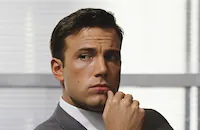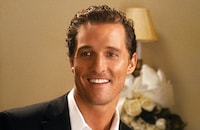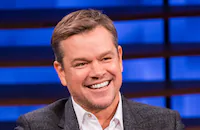Glory Daze
Brief Synopsis
Cast & Crew
Rich Wilkes
Ben Affleck
Sam Rockwell
Megan Ward
French Stewart
Vien Hong
Film Details
Technical Specs
Synopsis
At the University of California at Santa Cruz, the most notorious hot spot is the fraternity house nicknamed El Rancho Grande--part cess pool, part party central, part Gen-X commune. Graduation weights heavy on five of the frat boys as they prepare to go their separate ways. One boy, Jack, is unable to shake the gnawing fear that his beloved comrades will never recapture their sybaritic lifestyle. Graduation proves to be as torturous as the Rancho boys feared. An increasingly absurd series of encounters with assorted parents, girlfriends, professors and potential employers exacerbate their fears and force the young men to grapple with adulthood. The ultimate choice for the El Rancho Grande boys is to destroy the last vestige of their college days... the future can wait.
Cast

Ben Affleck
Sam Rockwell
Megan Ward
French Stewart
Vien Hong
Vinnie Deramus
Kristin Bauer
Alyssa Milano
John Rhys-davies

Mary Woronov
Tegan West

Matthew Mcconaughey
Sean Whalen
Christine Klotz
Christopher Slater
Elizabeth Ruscio
Spalding Gray
Brendan Fraser
Leah Remini
Jay Lacopo
Bob Libman
Matthey Hennesey
Soren Ray
Michael Stephen Ferrari

Matt Damon
Jacobi Wynne
Shane Matthews
Dan Ryan
Alfred Sole
Crew
Dick Stauff Acher
Nazli Afar
Ed Anders
Jeff Appelbaum
Jacqueline Arthur
John Ashker
C J Beach
Rebecca Benam
George Berndt
Dominik Black
Michael S Bloom
Jane Boegel
Javier J Bonafont
Javier Bonafont
Mary Beth Bonjour
Joe Boyle
Kristen Brickner
Rudy Brown
Reginald Bryant
Daniel Candib
Richard Candib
Bud Cardos
Susan Carpenter
Susan L Carpenter
Adam Cavert
James Christopher
Pat Conrad
Pat Conrad
Ronald Loy Cox
Don Davis
Sue Doell
Eric Dosch
Barry Dresner
Kristin Eaton
Chris Edward
John Edwards-younger
Felicia Fasano
Michael Stephen Ferrari
George Flores
Will Fouler
Stephanie Fowler
Stephanie Fowler
Nicholas Franchot
Michael Franco
Mark Gannel
Sean Garnett
Jordan S Green
Kathy Grieb
Jeff Hall
Paul Hargrove
Ian Harper
Drew Huffman
Victor Ivanov
Adam Jones
Tony Kadell
Kenny Kaplan
P. Gerald Knight
Jonathan Lally
Christian Lamb
Jim Lanahan
Dawn Laurel
Matt Leaventhal
Ashley Lemery
Susan Lewis
Micheal Lissauer
Tom Lovlett
Regina Lovlo
Carlo Maffirca
Matt Marky
Adolfo Martinez-perez
Caroline Mary
Christopher Medak
Jon Middleton
Jon Middleton
Chris Moore
Richard Nausworthy
William P O'reilly
Carlyce Olivieri
Peter Owen
Melanie Pearson
Sean Prichard
Carlton Prickett
John Pryor
David Ricardi
Mark Riccardi
Mark Riccardi
Christine Rodgers
Sabrina A Rosen
Jerry Ross
Sandy Sabatine
Joaquin Sancher
Charles Schner
Paul Sharpe
Liz Shimkus
Steve "shoe" Shoemaker
Andy Shuttleworth
Karol Siegel
David Silverstone
Mark Skilton
Christopher Slater
David Sobel
Alfred Sole
Mark A Sole
Ric Spencer
Francisco Stohr
Georgia Strachan
Larry Sushinski
Paul Tanzillo
Rafael S Tapia
Christopher Taylor
Martha Terry
Sarah K Thiessen
Victoria Thompson
Jeff Tomhave
Renee Tondelli
Lia Vollack
Diane Ward
Aaron M Weinberg
Matthew F Weinberg
Matthew F Weinberg
Rich Wilkes
William R Woodward
Jim Yant
Film Details
Technical Specs
Articles
Spalding Gray (1941-2004)
Gray was born in Barrington, Rhode Island on June 5, 1941, one of three sons born to Rockwell and Elizabeth Gray. He began pursuing an acting career at Emerson College in Boston. After graduation, he relocated to New York, where he acted in several plays in the late '60s and early '70s. He scored a breakthrough when he landed the lead role of Hoss in Sam Shepard's Off-Broadway hit Tooth of Crime in its 1973 New York premiere. Three years later he co-founded the avant-garde theatrical troupe, The Wooster Group with Willem Dafoe.
It was this period in the late '70s, when he was performing in Manhattan's underground theater circles, did Gray carve out his niche as a skilled monologist. His first formal monologue was about his childhood Sex and Death to the Age 14, performed at the Performing Garage in Manhattan in 1979; next came his adventures as a young university student Booze, Cars and College Girls in 1980; and the following year, he dealt with his chronicles as a struggling actor, A Personal History of the American Theater. These productions were all critical successes, and Gray soon became the darling of a small cult as his harrowing but funny takes on revealing the emotional and psychological cracks in his life brought some fresh air to the genre of performance art.
Although acting in small parts in film since the '70s, it wasn't until he garnered a role in The Killing Fields (1984), that he began to gain more prominent exposure. His experiences making The Killing Fields formed the basis of his one-man stage show Swimming to Cambodia which premiered on Off-Broadway in 1985. Both haunting and humorous, the plainsong sincerity of his performance exuded a raw immediacy and fragile power. Gray managed to relate his personal turmoil to larger issues of morality throughout the play, including absurdities in filmmaking, prostitution in Bangkok (where the movie was shot), and the genocidal reign of the Pol Pot. Gray won an Obie Award - the Off-Broadway's equivalent to the Tony Award - for his performance and two years later, his play was adapted by Jonathan Demme onto film, further broadening his acceptance as a unique and vital artistic talent.
After the success of Swimming to Cambodia, Gray found some work in the mainstream: Bette Midler's fiance in Beaches (1988), a regular part for one season as Fran Drescher's therapist in the CBS sitcom The Nanny (1989-90), a sardonic editor in Ron Howard's underrated comedy The Paper (1994), and a recent appearance as a doctor in Meg Ryan's romantic farce Kate & Leopold (2001). He also had two more of his monologues adapted to film: Monster in a Box (1992) and Gray's Anatomy (1996). Both films were further meditations on life and death done with the kind of biting personal wit that was the charming trademark of Gray.
His life took a sudden downturn when he suffered a frightening head-on car crash during a 2001 vacation in Ireland to celebrate his 60th birthday. He suffered a cracked skull, a broken hip and nerve damage to one foot and although he recovered physically, the incident left him traumatized. He tried jumping from a bridge near his Long Island home in October 2002. Family members, fearing for his safety, and well aware of his family history of mental illness (his mother committed suicide in 1967) convinced him to seek treatment in a Connecticut psychiatric hospital the following month.
Sadly, despite his release, Gary's mental outlook did not improve. He was last seen leaving his Manhattan apartment on January 10, and witnesses had reported a man fitting Gray's description look despondent and upset on the Staten Island Ferry that evening. He is survived by his spouse Kathleen Russo; two sons, Forrest and Theo; Russo's daughter from a previous relationship, Marissa; and two brothers, Rockwell and Channing.
by Michael T. Toole

Spalding Gray (1941-2004)
Quotes
Trivia
Miscellaneous Notes
Released in United States Fall September 27, 1996
Released in United States January 1996
Released in United States October 11, 1996
Released in United States October 1995
Released in United States on Video October 7, 1997
Released in United States September 1995
Shown at Hamptons International Film Festival October 18-22, 1995.
Shown at Independent Feature Film Market (IFFM) in New York City under title "Cruz" September 17-24, 1995.
Shown at Nortel Palm Springs International Film Festival in Palm Springs, California January 5-21, 1996.
Shown at Slamdance International Film Festival & Market (in competition) in Park City, Utah January 18-28, 1996.
Feature directorial debut for veteran screenwriter Rich Wilkes.
Began shooting September 19, 1994.
Completed shooting late October 1994.
Cruz Partners was also involved in the production of this feature.
Released in United States January 1996 (Shown at Nortel Palm Springs International Film Festival in Palm Springs, California January 5-21, 1996.)
Released in United States January 1996 (Shown at Slamdance International Film Festival & Market (in competition) in Park City, Utah January 18-28, 1996.)
Released in United States September 1995 (Shown at Independent Feature Film Market (IFFM) in New York City under title "Cruz" September 17-24, 1995.)
Released in United States Fall September 27, 1996
Released in United States October 1995 (Shown at Hamptons International Film Festival October 18-22, 1995.)
Released in United States on Video October 7, 1997
Released in United States October 11, 1996 (Austin, Texas)













